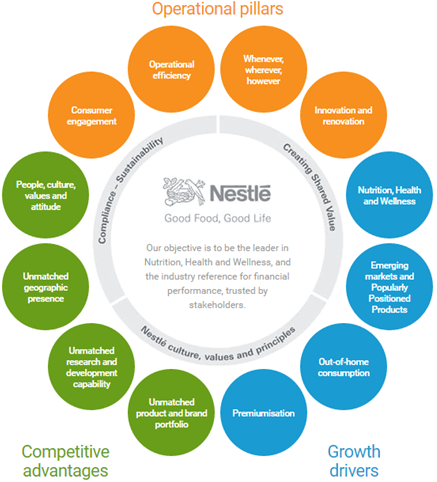In order to have full access of this Article,Innovation Practices and Issue faced by Nestle please email us on thedocumentco@hotmail.co.uk
Introduction:
Nestle, a Swiss company by origin, started on its path in 1867 when the founder Henri Nestle made infant food “Farine Lactee” and made a difference in the lives of many people (Parsons, 1996). Till today, Nestle has been evolving and growing and has made its way from store shelves to our refrigerators, dining and bedside tables. The products of Nestle range from dairy products to pet-care, confectionery to skin care and frozen foods to beverages.
From the nineteenth century till date, food industry and nutrition have been modified in countless ways and Nestle has been coming up with the challenges of malnutrition, obesity ageing and growing by making good food for good lives. Nestle is currently operating in over 197 countries and its success is rooted in its going with the tide and persistent innovation (“‘Good Food, Good Life’: Innovation Practices and Issue faced by Nestle Celebrating 150 years of Nestlé”, 2017).
These innovations have not always been received with enthusiasm and have often led to rise and falls in the status of the firm (Pagan, 1986) but have made Nestle one of the industrial giants and more than a billion servings of Nestle products are consumed per annum (“‘Good Food, Good Life’:
Celebrating 150 years of Nestlé”, 2017). According to Nestle, whereas taste is the primary choice of the customer, nutrition and sustainability is also important for the customer. The R&D is further making advancements in ways to reduce salt, sugar and fats without compromising the taste in order to keep pace with recent developments in nutrition trends(Gray, 2015).
Discussion:
Nestle, since its beginning, has always been striving to improve people’s lives. Innovation Practices and Issue faced by Nestle The struggle to make their products healthier and tastier is fueled by an extensive and largest, claimed by Nestle, Research and Development network comprising of 34 facilities and a wide pool of engineers, scientists, nutritionists and regulatory specialists working hard to earn the trust of the consumer and achieve the highest quality of a product.
There are a well-established innovation and renovation methodology for the production of new and better product at Nestle. A brief comprising of all the details about a new product is prepared by R&D and if accepted sample preparations of the product are produced and evaluated by a panel of specialists through an interactive mechanism.
Necessary changes are made and the test production of 1 tonne is produced. The price adjustment is made by the R&D and then finalized in the same way. Feedbacks and suggestions lead to the development of the final product(New Product Development at Nestlé – Nestlé | Nestlé case studies, videos, social media and information | Business Case Studies”, n.d.).
With the increasing incidence of cardiovascular diseases such as strokes and high blood pressure, the issue of high sodium consumption has been widely addressed all over the world. Excessive consumption of salt is directly associated with high blood pressure. A huge number of U.S. Population consumes more than the required amount of sodium which according to the guidelines should be less than 2300mg. About three quarters of the total sodium consumed was taken from the stores.
Nestle including other leading food industries is concerned about this health issue. Recent researches and developments are under process to reduce the amount of salt added to the foods. According to WHO, daily consumption of sodium should be less than 2g per day which is equal to 5g of salt (“Salt reduction”, 2017). In view of the amount of sodium consumption contributed by packaged food,
Nestle is investing to play its part. But, reducing the salt content can reduce the appeal and decrease the taste of the product thus economically destabilizing the product or can result in an addition of salt to the food by the consumer on the table which is worse.
According to Nestle survey results, 71% people will choose the healthier food available, 37% will neglect health risks due to greater appeal of the product and only 27% are willing to make a great change in order to eat healthily. Research and Development department is trying to achieve a lower sodium component so to prevent the excessive intake of sodium without compromising on the appeal and taste of the product (Burrows, 2016).
This reduction of salt is a sustaining innovation as the need and way to the problem is known and Nestle produces these goods on a larger scale and reviews are collected, as customers’ preferences should not be compromised.
The innovation is the requirement of the time has a time frame to achieve the target of reducing sodium in ten percent of the products that currently are not in-line with the sodium guidelines. Nestle is investing in development strategies and technology that reduces…


Recent Comments